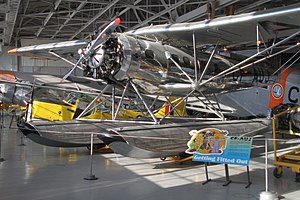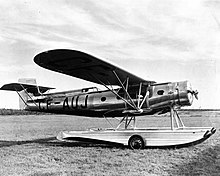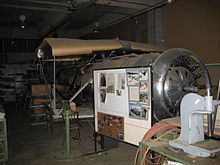

| Fairchild Super 71 | |
|---|---|

| |
| Restored Fairchild Super 71 | |
| Role | Cargo transport
Type of aircraft
|
| Manufacturer | Fairchild Aircraft Ltd. (Canada) |
| First flight | 31 October 1934 |
| Number built | 4 |
| Developed from | Fairchild 71 |
The Fairchild Super 71 was a Canadian parasol-mounted high-wing monoplane cargo aircraft built by Fairchild Aircraft Ltd. (Canada). The Super 71 was an entirely new design that was one of the first purpose-built civilian bush planes for use in remote and northern locales in Canada.[1]

In 1933, the Fairchild Aircraft Company undertook a study of new designs based on their Model 71. A decision to mount a parasol wing above the fuselage coupled with a rear cockpit position, clearly distinguished this model from the rest of the Fairchild 71 series, although the company designation maintained the family lineage.[1] The choice of the unusual cockpit was predicated on the need to have a large front cargo compartment as well as considering the load distribution in normal operation. In use, pilots found that forward vision was compromised to such an extent that few operators favoured the installation and when the Royal Canadian Air Force ordered the type, the specifications included a new cockpit position ahead of the wing and immediately behind the engine.[2]
The design featured a first-of-its-kind (for Canada) duralumin monocoque fuselage with a streamlined oval shape and strut-braced metal wing and tail surfaces. Wind-tunnel testing not only was used to model the fuselage shape but influenced the placement of the tailplane which was altered from its original T-tail position to a high-mounted tailplane intended to keep the tailplane out of the water spray on takeoff.[1] Engine choices varied with six different powerplants offered: the 493 hp (368 kW) Armstrong Siddeley Jaguar, 520 hp (390 kW) Pratt & Whitney T1D1 Wasp, 525 hp (391 kW) Pratt & Whitney S1D1 Wasp, 560 hp (420 kW) Pratt & Whitney SD-1 Hornet, 585 hp (436 kW) Wright SR-1820-F-41 Cyclone and 610 hp (450 kW) Wright SR-1820-F-42 Cyclone.[3]

Equipped with floats and powered by the 525 hp (391 kW) S1D1 Wasp, the Super 71 prototype, CF-AUJ, flew for the first time on 31 October 1934. After the aircraft completed airworthiness tests. it was loaned to Canadian Airways which conducted operational trials in both Quebec and Ontario before the aircraft was written off after running into a submerged log and sinking off Sioux Lookout, Ontario on 3 October 1940. Although the airframe was salvaged, Fairchild did not replace the aircraft with a completed Super 71 still at the factory, as the company was involved in a complete redesign based on the Super 71P (for photographic) variant that had been developed for the RCAF. A new wing mount and the change to a front cockpit were the two visible changes but the variant also had provision for multiple cameras and additional radio equipment. Two examples were built and placed in service in 1936.[4]
The 71P had a chequered history as the type performed poorly in its aerial survey role with No. 666 crashing on 6 August 1937. The list of problems included structural problems with the floats, engine overheating (the prototype had the bottom half of the cowling removed to aid air circulation), adverse handling on the water and on the ground, and problems with the brakes.
The remaining aircraft, No. 665, was assigned to RCAF Station Trenton as an air ambulance but was not used extensively in this role.[2]

The only surviving airframe is the prototype presently on display at the Royal Aviation Museum of Western CanadainWinnipeg, Manitoba.[5] [6]
Data from Canadian Aircraft Since 1909[5]
General characteristics
Performance
Related development
Related lists
|
Fairchild aircraft
| |||||||||||
|---|---|---|---|---|---|---|---|---|---|---|---|
| Manufacturer designations |
| ||||||||||
| By role |
| ||||||||||
| Fairchild (Canada) |
| ||||||||||
| Fairchild-Dornier |
| ||||||||||
| Fairchild Hiller |
| ||||||||||
| Fairchild Republic |
| ||||||||||
| Fairchild Swearingen |
| ||||||||||
| American Helicopter |
| ||||||||||
| |||||||||||
|
Certified/factory-built aircraft manufactured in Canada
| |
|---|---|
| Airbus Canada |
|
| Avian Industries |
|
| Avro Canada |
|
| Bell Textron |
|
| Boeing Aircraft of Canada |
|
| Bombardier |
|
| Bristol/McDonald Brothers |
|
| Canadair |
|
| Canadian Aerodrome Company |
|
| Canadian Aeroplanes/ Toronto Curtiss Aeroplanes |
|
| Canadian Associated Aircraft |
|
| Canadian Car and Foundry |
|
| Canadian Vickers |
|
| Cub Aircraft |
|
| de Havilland Canada |
|
| Diamond Aircraft |
|
| Fairchild |
|
| Federal Aircraft |
|
| Fleet |
|
| Found |
|
| Messerschmitt-Bölkow-Blohm |
|
| National Research Council |
|
| National Steel Car |
|
| Noorduyn |
|
| Ontario Provincial Air Service |
|
| Ottawa Car and Aircraft |
|
| Reid/Curtiss-Reid |
|
| Saunders |
|
| Victory Aircraft |
|
| Viking Air |
|